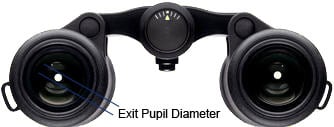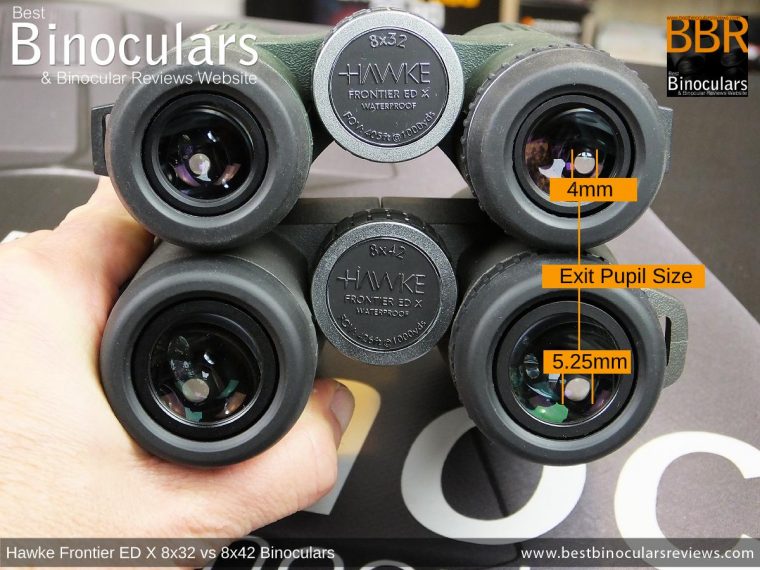Does Age Affect Image Brightness in Binoculars?
This week I received an interesting question from Andre in the Netherlands who wants to know if your age affects how bright an image you are able to see when looking through binoculars with different configurations:

Question
Hi, Andre from holland.
In your tests, I see nothing about if you are a little older then your eyes can’t see the differences between a 7x50 and a 7x35 binocular in brightness. (I have read this somewhere if I am not mistaken)
In other words: if I go with the 7x50 the views would be not brighter for my eyes than a 7x35. But, is this really true??
Thanks for the tip!
Answer
Hi Andre,
Many thanks for the question and yes, it is true that your age can certainly affect how effective a binocular will be in low light, or perhaps it is better for me to say your age can affect just how bright you perceive the image to be when looking through a pair of binoculars, but there are many other factors to consider as well:

Pupil Size vs Exit Pupil Size
The reason for this all relates to the relationship between the maximum size that your pupils can dilate to in low light conditions and the exit pupil size on the binoculars (the size of the shafts of light exiting the eyepieces).
Pupil Size
As you may know, in low light your pupils enlarge in order to take in more light, but being human, we are not all the same, and on top of that, as you get older, your body becomes less proficient at many things and this includes how much your pupils can enlarge!
So a rough guide and as I understand it, the maximum pupil size of a human eye is typically between 5mm to 9mm for adults below 25 years of age (usually about 7mm), and with age, your maximum slowly decreases.

Exit Pupil Size in Different Binoculars
I have already written a complete guide to the exit pupil on Binoculars, which I recommend you also take a look at, but for the purposes of this question on how it affects perceived image brightness and how this relates to the viewer’s age, we just need to understand a few main points:
- Different configurations of binoculars (7x50, 7x35, 8x32, 8x42 for example) produce different sizes of exit pupils (as is shown in the image below).
- The exit pupil size is determined by the size of the lenses and the magnification of binocular using the following equation: Lens Diameter (mm) ÷ magnification = exit pupil size (mm)
- So an 8x42 will usually produce a 5.25mm exit pupil (42÷8), an 8x32 has 4mm ones and in your examples, a 7x50 has 7.1mm exit pupils and the 7x35 has 5mm ones.
- If the exit pupil is smaller than your current pupil dilation, your eyes are wanting more light but not receiving it
- If the exit pupil size is larger than your current pupil dilation, your eyes are getting more than enough light

Young Adult
So if we take the average maximum pupil size for a young adult as being 7mm, then using the examples above we could say that in good light conditions, when their pupils are small, all four configurations would be supplying the user with more light than they need to perceive a bright image.
However, in very low light and when looking at dull objects, when their pupils are fully open to 7mm, only the 7x50 would be offering more than enough light than needed for the user to perceive an image brightness on a par with what you would expect to see without binoculars.
So assuming the quality of optical glass and coatings on all binoculars were exactly the same (which is usually not the case!), the 7x50 would the best option in these conditions as they would likely seem to be producing a brighter image to that person than the other configurations.
Please note that this is not always straightforward, as there there are many other factors at play. For example, you have to take into consideration the quality of the optics as this makes a big difference (see How to Choose Binoculars for which features are most important and which are marketing hype).
Also, the magnification can affect your perception, as a higher power may result in you being able to observe more detail even though the image may not be as bright.
Older Person
Now as you get older, they say that your pupils are less able to open up, however, I have never been able to find out more exact information than that and obviously this also all depends on what your maximum size was to start with when you were young!
But in principle, and for argument’s sake, let us say your maximum was now down to 5mm.
Taking the same examples above and in low light conditions, the 7x50 with its 7.1mm exit pupil, the 8x42 (5.25mm), and the 7x35 (5mm) would all be supplying your eyes with enough, or more than enough light than what your eyes can physically take in and thus assuming all else is equal, in theory, all would seem to you to produce an image of equal brightness and it is only the 8x32 that would seem less bright to that person.
As I say, there are many other factors at play, but this is in theory why there may not be any major advantage for an older person to have a larger 7x50 binocular in low light than a 7x35 binocular.
I hope this all makes sense and I am sorry that I can be more precise in my answer!

 Article | Posted by Best Binocular Reviews
Article | Posted by Best Binocular Reviews 
 Categories:
Categories:  Tags:
Tags: 
